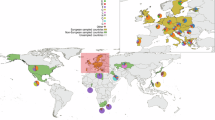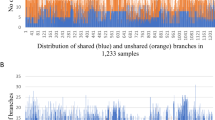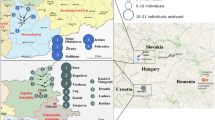Abstract
Phylogenetically informative Y chromosomal single-nucleotide polymorphisms (Y-SNPs) integrated in DNA chips have not been sufficiently explored in most genome-wide association studies (GWAS). Herein, we introduce a pipeline to retrieve Y-SNP data. We introduce the software YTool (http://mitotool.org/ytool/) to handle conversion, filtering, and annotation of the data. Genome-wide SNP data from populations in Myanmar are used to construct a haplogroup tree for 117 Y chromosomes based on 369 high-confidence Y-SNPs. Parallel genotyping and published resequencing data of Y chromosomes confirm the validity of our pipeline. We apply this strategy to the CEU HapMap data set and construct a haplogroup tree with 107 Y-SNPs from 39 individuals. The retrieved Y-SNPs can discern the parental genetic structure of populations. Given the massive quantity of data from GWAS, this method facilitates future investigations of Y chromosome diversity.
Similar content being viewed by others
Log in or create a free account to read this content
Gain free access to this article, as well as selected content from this journal and more on nature.com
or
References
Jobling MA, Tyler-Smith C : The human Y chromosome: an evolutionary marker comes of age. Nat Rev Genet 2003; 4: 598–612.
Y Chromosome Consortium: A nomenclature system for the tree of human Y-chromosomal binary haplogroups. Genome Res 2002; 12: 339–348.
Underhill PA, Kivisild T : Use of Y chromosome and mitochondrial DNA population structure in tracing human migrations. Annu Rev Genet 2007; 41: 539–564.
Karafet TM, Mendez FL, Meilerman MB, Underhill PA, Zegura SL, Hammer MF : New binary polymorphisms reshape and increase resolution of the human Y chromosomal haplogroup tree. Genome Res 2008; 18: 830–838.
Chiaroni J, Underhill PA, Cavalli-Sforza LL : Y chromosome diversity, human expansion, drift, and cultural evolution. Proc Natl Acad Sci USA 2009; 106: 20174–20179.
King TE, Jobling MA : What's in a name? Y chromosomes, surnames and the genetic genealogy revolution. Trends Genet 2009; 25: 351–360.
Kayser M, de Knijff P : Improving human forensics through advances in genetics, genomics and molecular biology. Nat Rev Genet 2011; 12: 179–192.
Charchar FJ, Bloomer LD, Barnes TA et al: Inheritance of coronary artery disease in men: an analysis of the role of the Y chromosome. Lancet 2012; 379: 915–922.
Fan JB, Chee MS, Gunderson KL : Highly parallel genomic assays. Nat Rev Genet 2006; 7: 632–644.
Hinds DA, Stuve LL, Nilsen GB et al: Whole-genome patterns of common DNA variation in three human populations. Science 2005; 307: 1072–1079.
Makowsky R, Yan Q, Wiener HW et al: The utility of mitochondrial and y chromosome phylogenetic data to improve correction for population stratification. Front Genet 2012; 3: 301.
Chaubey G, Metspalu M, Choi Y et al: Population genetic structure in Indian Austroasiatic speakers: the role of landscape barriers and sex-specific admixture. Mol Biol Evol 2011; 28: 1013–1024.
Wang Z : The Jingpo: Kachin of the Yunnan Plateau. Tempe: Arizona State University, 1997.
Li JZ, Absher DM, Tang H et al: Worldwide human relationships inferred from genome-wide patterns of variation. Science 2008; 319: 1100–1104.
Purcell S, Neale B, Todd-Brown K et al: PLINK: a tool set for whole-genome association and population-based linkage analyses. Am J Hum Genet 2007; 81: 559–575.
Hughes JF, Rozen S : Genomics and genetics of human and primate Y chromosomes. Annu Rev Genomics Hum Genet 2012; 13: 83–108.
Skaletsky H, Kuroda-Kawaguchi T, Minx PJ et al: The male-specific region of the human Y chromosome is a mosaic of discrete sequence classes. Nature 2003; 423: 825–837.
Bandelt HJ, Forster P, Röhl A : Median-joining networks for inferring intraspecific phylogenies. Mol Biol Evol 1999; 16: 37–48.
International Society of Genetic Genealogy. 2013, Y-DNA Haplogroup Tree 2013. Version: 8.20, Date: 26 February 2013 http://www.isogg.org/tree/ Accessed on: 28 Februray 2013..
He JD, Peng MS, Quang HH et al: Patrilineal perspective on the Austronesian diffusion in Mainland Southeast Asia. PLoS One 2012; 7: e36437.
Karafet TM, Hallmark B, Cox MP et al: Major east-west division underlies Y chromosome stratification across Indonesia. Mol Biol Evol 2010; 27: 1833–1844.
Debnath M, Palanichamy MG, Mitra B, Jin JQ, Chaudhuri TK, Zhang YP : Y-chromosome haplogroup diversity in the sub-Himalayan Terai and Duars populations of East India. J Hum Genet 2011; 56: 765–771.
Wei W, Ayub Q, Chen Y et al: A calibrated human Y-chromosomal phylogeny based on resequencing. Genome Res 2013; 23: 388–395.
Adams SM, King TE, Bosch E, Jobling MA : The case of the unreliable SNP: recurrent back-mutation of Y-chromosomal marker P25 through gene conversion. Forensic Sci Int 2006; 159: 14–20.
Cruciani F, Trombetta B, Novelletto A, Scozzari R : Recurrent mutation in SNPs within Y chromosome E3b (E-M215) haplogroup: a rebuttal. Am J Hum Biol 2008; 20: 614–616.
Richards M, Macaulay V, Torroni A, Bandelt HJ : In search of geographical patterns in European mitochondrial DNA. Am J Hum Genet 2002; 71: 1168–1174.
Excoffier L, Smouse PE, Quattro JM : Analysis of molecular variance inferred from metric distances among DNA haplotypes: application to human mitochondrial DNA restriction data. Genetics 1992; 131: 479–491.
Ballantyne KN, Goedbloed M, Fang R et al: Mutability of Y-chromosomal microsatellites: rates, characteristics, molecular bases, and forensic implications. Am J Hum Genet 2010; 87: 341–353.
Cruciani F, Trombetta B, Massaia A, Destro-Bisol G, Sellitto D, Scozzari R : A revised root for the human Y chromosomal phylogenetic tree: the origin of patrilineal diversity in Africa. Am J Hum Genet 2011; 88: 814–818.
Xue Y, Wang Q, Long Q et al: Human Y chromosome base-substitution mutation rate measured by direct sequencing in a deep-rooting pedigree. Curr Biol 2009; 19: 1453–1457.
Acknowledgements
We are grateful to all volunteers and samplers. We thank Zhong-Yin Zhou, Wen-Zhi Wang, and Ni-Ni Shi for technical assistance. This study was supported by grants from National Natural Science Foundation of China and Bureau of Science and Technology of Yunnan Province. The Youth Innovation Promotion Association, Chinese Academy of Sciences provided support to M-SP. This work was also supported, in part, by a Visiting Professorship for Senior International Scientists from the Chinese Academy of Sciences, and manuscript preparation by a Natural Sciences and Engineering Research Council of Canada Discovery Grant A3148 to RWM.
Author information
Authors and Affiliations
Corresponding author
Ethics declarations
Competing interests
The authors declare no conflict of interest.
Additional information
Supplementary Information accompanies this paper on European Journal of Human Genetics website
Rights and permissions
About this article
Cite this article
Peng, MS., He, JD., Fan, L. et al. Retrieving Y chromosomal haplogroup trees using GWAS data. Eur J Hum Genet 22, 1046–1050 (2014). https://doi.org/10.1038/ejhg.2013.272
Received:
Revised:
Accepted:
Published:
Issue date:
DOI: https://doi.org/10.1038/ejhg.2013.272
Keywords
This article is cited by
-
Reconstruction of Y-chromosome phylogeny reveals two neolithic expansions of Tibeto-Burman populations
Molecular Genetics and Genomics (2018)
-
No association between Y chromosomal haplogroups and severe acne in the Han Chinese population
Journal of Human Genetics (2014)



